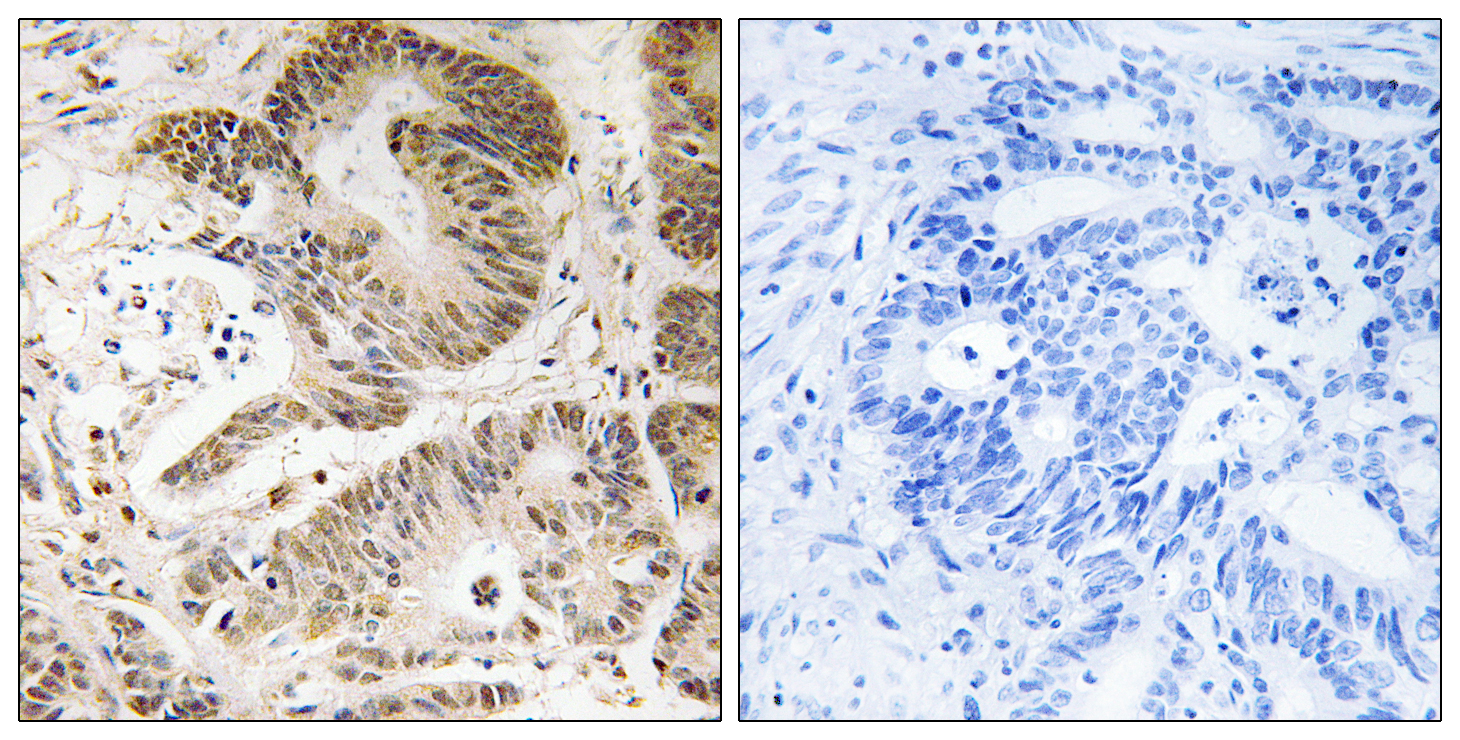PI 3-kinase p101 Polyclonal Antibody
- Catalog No.:YT3708
- Applications:WB;IHC;IF;ELISA
- Reactivity:Human;Mouse
- Target:
- PI 3-kinase p101
- Fields:
- >>cGMP-PKG signaling pathway;>>Chemokine signaling pathway;>>Phospholipase D signaling pathway;>>PI3K-Akt signaling pathway;>>Adrenergic signaling in cardiomyocytes;>>Apelin signaling pathway;>>Platelet activation;>>Cholinergic synapse;>>Oxytocin signaling pathway;>>Toxoplasmosis;>>Kaposi sarcoma-associated herpesvirus infection
- Gene Name:
- PIK3R5
- Protein Name:
- Phosphoinositide 3-kinase regulatory subunit 5
- Human Gene Id:
- 23533
- Human Swiss Prot No:
- Q8WYR1
- Mouse Gene Id:
- 320207
- Mouse Swiss Prot No:
- Q5SW28
- Immunogen:
- The antiserum was produced against synthesized peptide derived from human PIK3R5. AA range:695-744
- Specificity:
- PI 3-kinase p101 Polyclonal Antibody detects endogenous levels of PI 3-kinase p101 protein.
- Formulation:
- Liquid in PBS containing 50% glycerol, 0.5% BSA and 0.02% sodium azide.
- Source:
- Polyclonal, Rabbit,IgG
- Dilution:
- WB 1:500 - 1:2000. IHC 1:100 - 1:300. ELISA: 1:20000.. IF 1:50-200
- Purification:
- The antibody was affinity-purified from rabbit antiserum by affinity-chromatography using epitope-specific immunogen.
- Concentration:
- 1 mg/ml
- Storage Stability:
- -15°C to -25°C/1 year(Do not lower than -25°C)
- Other Name:
- PIK3R5;Phosphoinositide 3-kinase regulatory subunit 5;PI3-kinase regulatory subunit 5;PI3-kinase p101 subunit;Phosphatidylinositol 4;5-bisphosphate 3-kinase regulatory subunit;PtdIns-3-kinase regulatory subunit;Protein FOAP-2;PtdIns-
- Observed Band(KD):
- 100kD
- Background:
- Phosphatidylinositol 3-kinases (PI3Ks) phosphorylate the inositol ring of phosphatidylinositol at the 3-prime position, and play important roles in cell growth, proliferation, differentiation, motility, survival and intracellular trafficking. The PI3Ks are divided into three classes: I, II and III, and only the class I PI3Ks are involved in oncogenesis. This gene encodes the 101 kD regulatory subunit of the class I PI3K gamma complex, which is a dimeric enzyme, consisting of a 110 kD catalytic subunit gamma and a regulatory subunit of either 55, 87 or 101 kD. This protein recruits the catalytic subunit from the cytosol to the plasma membrane through high-affinity interaction with G-beta-gamma proteins. Multiple alternatively spliced transcript variants encoding two distinct isoforms have been found. [provided by RefSeq, Oct 2011],
- Function:
- domain:The heterodimerization region allows the binding to the catalytic subunit.,enzyme regulation:Greatly activated by G gamma proteins.,function:Regulatory subunit of the PI3K gamma complex.,subunit:Heterodimer of a catalytic subunit (PIK3CG/p120) and a regulatory (PIK3R5a/p101) subunit. Interacts with G beta gamma proteins.,tissue specificity:Highly expressed in leukocytes, followed by spleen, lymph node, thymus ans bone marrow.,
- Subcellular Location:
- Nucleus . Cytoplasm . Cell membrane ; Peripheral membrane protein . Predominantly localized in the nucleus in absence of PIK3CG/p120. Colocalizes with PIK3CG/p120 in the cytoplasm. Translocated to the plasma membrane in a beta-gamma G protein-dependent manner. .
- Expression:
- Ubiquitously expressed with high expression in fetal brain compared to adult brain. Abundant expression is observed in cerebellum, cerebral cortex, cerebral meninges, and vermis cerebelli.
- June 19-2018
- WESTERN IMMUNOBLOTTING PROTOCOL
- June 19-2018
- IMMUNOHISTOCHEMISTRY-PARAFFIN PROTOCOL
- June 19-2018
- IMMUNOFLUORESCENCE PROTOCOL
- September 08-2020
- FLOW-CYTOMEYRT-PROTOCOL
- May 20-2022
- Cell-Based ELISA│解您多样本WB检测之困扰
- July 13-2018
- CELL-BASED-ELISA-PROTOCOL-FOR-ACETYL-PROTEIN
- July 13-2018
- CELL-BASED-ELISA-PROTOCOL-FOR-PHOSPHO-PROTEIN
- July 13-2018
- Antibody-FAQs
- Products Images

- Immunohistochemistry analysis of paraffin-embedded human colon carcinoma tissue, using PIK3R5 Antibody. The picture on the right is blocked with the synthesized peptide.



